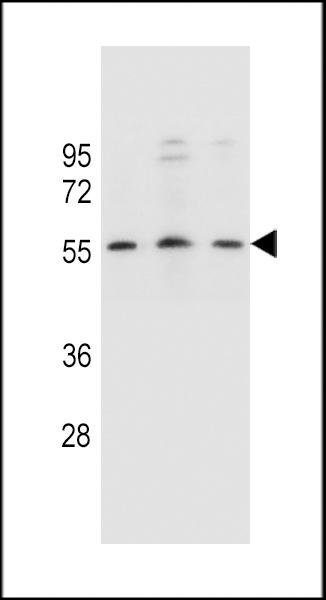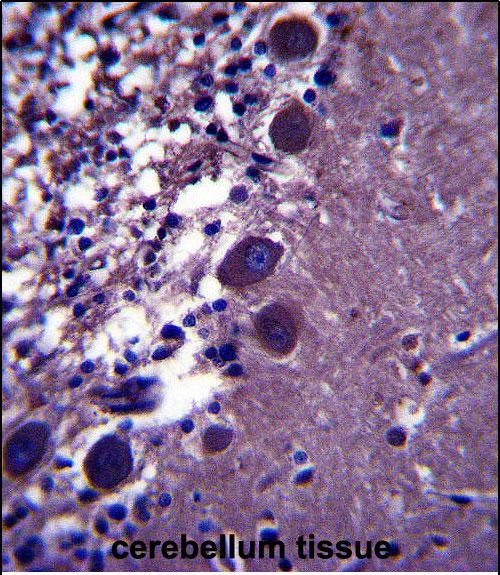KCNK18 Antibody (Center)
Affinity Purified Rabbit Polyclonal Antibody (Pab)
- SPECIFICATION
- CITATIONS
- PROTOCOLS
- BACKGROUND

Application
| IHC-P, WB, E |
|---|---|
| Primary Accession | Q7Z418 |
| Other Accession | NP_862823.1 |
| Reactivity | Human |
| Host | Rabbit |
| Clonality | Polyclonal |
| Isotype | Rabbit IgG |
| Calculated MW | 43671 Da |
| Antigen Region | 168-197 aa |
| Gene ID | 338567 |
|---|---|
| Other Names | Potassium channel subfamily K member 18, TWIK-related individual potassium channel, TWIK-related spinal cord potassium channel, KCNK18, TRESK, TRIK |
| Target/Specificity | This KCNK18 antibody is generated from rabbits immunized with a KLH conjugated synthetic peptide between 168-197 amino acids from the Central region of human KCNK18. |
| Dilution | IHC-P~~1:10~50 WB~~1:1000 E~~Use at an assay dependent concentration. |
| Format | Purified polyclonal antibody supplied in PBS with 0.09% (W/V) sodium azide. This antibody is purified through a protein A column, followed by peptide affinity purification. |
| Storage | Maintain refrigerated at 2-8°C for up to 2 weeks. For long term storage store at -20°C in small aliquots to prevent freeze-thaw cycles. |
| Precautions | KCNK18 Antibody (Center) is for research use only and not for use in diagnostic or therapeutic procedures. |
| Name | KCNK18 {ECO:0000303|PubMed:22355750, ECO:0000312|HGNC:HGNC:19439} |
|---|---|
| Function | K(+) channel that conducts outward and inward rectifying currents at depolarized and hyperpolarized membrane potentials, respectively. The outward rectifying currents are voltage-dependent, coupled to K(+) electrochemical gradient across the membrane, whereas the inward currents can be induced in response to activation of Ca(2+)- mobilizing receptors (PubMed:12754259, PubMed:15562060, PubMed:20871611, PubMed:22355750, PubMed:26919430, PubMed:30573346). Homo- and heterodimerizes to form functional channels with distinct regulatory and gating properties. In trigeminal ganglia sensory neurons, the heterodimers of KCNK18/TRESK and KCNK2/TREK-1 or KCNK10/TREK-2 inhibit neuronal firing and neurogenic inflammation by stabilizing the resting membrane potential at K(+) equilibrium potential as well as by regulating the threshold of action potentials and the spike frequency (By similarity). In thymocytes, conducts K(+) currents upon T cell receptor (TCR) signaling leading to sustained Ca(2+) influx and NF-kappa-B activation, FOXP3 transcription and positive selection of regulatory T cell (Treg) progenitor subsets (PubMed:34702947). Appears to mediate the analgesics effects of hydroxy-alpha-sanshool, a metabolite naturally present in Schezuan pepper and other Xanthoxylum plants (By similarity). |
| Cellular Location | Cell membrane; Multi-pass membrane protein |
| Tissue Location | Expressed in dorsal root ganglion and trigeminal ganglion neurons. Detected at low levels in spinal cord. Expressed in regulatory T cells (at protein level). |

Thousands of laboratories across the world have published research that depended on the performance of antibodies from Abcepta to advance their research. Check out links to articles that cite our products in major peer-reviewed journals, organized by research category.
info@abcepta.com, and receive a free "I Love Antibodies" mug.
Provided below are standard protocols that you may find useful for product applications.
Background
Two-pore domain potassium channels, such as KCNK18, give rise to background, or leak, potassium conductance, and they regulate diverse cellular functions by adjusting both the resting membrane potential and excitability. KCNK18 is unique among this family of potassium channels in that its activity is regulated by intracellular calcium (summary by Czirjak and Enyedi, 2006 [PubMed 16569637]).
References
Lafreniere, R.G., et al. Nat. Med. 16(10):1157-1160(2010)
Rose, J.E., et al. Mol. Med. 16 (7-8), 247-253 (2010) :
Egenberger, B., et al. Biochem. Biophys. Res. Commun. 391(2):1262-1267(2010)
Pottosin, I.I., et al. Pflugers Arch. 456(6):1037-1048(2008)
Czirjak, G., et al. J. Biol. Chem. 283(23):15672-15680(2008)
If you have used an Abcepta product and would like to share how it has performed, please click on the "Submit Review" button and provide the requested information. Our staff will examine and post your review and contact you if needed.
If you have any additional inquiries please email technical services at tech@abcepta.com.













 Foundational characteristics of cancer include proliferation, angiogenesis, migration, evasion of apoptosis, and cellular immortality. Find key markers for these cellular processes and antibodies to detect them.
Foundational characteristics of cancer include proliferation, angiogenesis, migration, evasion of apoptosis, and cellular immortality. Find key markers for these cellular processes and antibodies to detect them. The SUMOplot™ Analysis Program predicts and scores sumoylation sites in your protein. SUMOylation is a post-translational modification involved in various cellular processes, such as nuclear-cytosolic transport, transcriptional regulation, apoptosis, protein stability, response to stress, and progression through the cell cycle.
The SUMOplot™ Analysis Program predicts and scores sumoylation sites in your protein. SUMOylation is a post-translational modification involved in various cellular processes, such as nuclear-cytosolic transport, transcriptional regulation, apoptosis, protein stability, response to stress, and progression through the cell cycle. The Autophagy Receptor Motif Plotter predicts and scores autophagy receptor binding sites in your protein. Identifying proteins connected to this pathway is critical to understanding the role of autophagy in physiological as well as pathological processes such as development, differentiation, neurodegenerative diseases, stress, infection, and cancer.
The Autophagy Receptor Motif Plotter predicts and scores autophagy receptor binding sites in your protein. Identifying proteins connected to this pathway is critical to understanding the role of autophagy in physiological as well as pathological processes such as development, differentiation, neurodegenerative diseases, stress, infection, and cancer.



